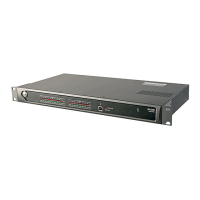• Ratio Sets the aggressiveness of the Compressor by controlling the slope of
the input/output transfer curve. Once the signal exceeds the Threshold,
the Ratio dictates the amount that the input volume must increase (in
dB) to produce a 1 dB increase in output volume. For example, with a
[4:1] Ratio, a 12 dB increase in input volume produces a 3 dB increase
in output volume.
• Attack Determines the rate at which the Compressor reduces gain. The rate is
determined by the formula (15/[Attack]) dB/sec.
• Release Determines the rate at which the Compressor increases gain. The rate
is determined by the formula (15/[Release]) dB/sec.
• Gain Makeup Applies a fixed amount of gain boost at the output of the Compressor to
makeup for loss in overall volume caused by high Ratio and/or low
Threshold settings.
• Bypass Compressor Bypasses the Compressor/AGC without changing
the Compressor’s settings.
AGC
Description
The DX1208 Compressors can alternately function as an Automatic Gain Control (AGC).
AGCs are designed to dynamically normalize the volume of an audio signal to a defined output
level, regardless of the input signal level. AGCs are used to ‘level’ out multiple program
sources to roughly equalize their relative volumes or set their volumes in a predefined
relationship. For example the outputs from a TV, CD player, and radio may all be distributed
through an overhead speaker system to patrons in a restaurant or bar. The program level of
the different TV stations, programs and songs will vary widely, but all need to be sent to the
speakers at a relatively constant volume so that quiet material will not be drowned out by the
background noise, and loud material will not be distracting: When the program material is
louder than the ‘target’ volume level, the AGC reduces the volume; when it is quieter than the
target, it increases the volume.
While the AGC retains some of the characteristics of a compressor, there are several key
differences between an AGC and Compressor:
• The rate at which an AGC makes its volume adjustments generally closely
approximates the rate at which a human might adjust the volume of a source, and
therefore program dynamics are preserved. Compressors on the other hand are setup
to act much faster and therefore will compress the dynamic range of the signal.
• A compressor only reduces the gain of a signal. An AGC both reduces the gain when
the signal level is above the target, and increases the gain when it is below the target.
• The AGC has a ‘gain hold’ function which prevents the volume from changing once the
signal drops below a certain minimum level (usually called the silence threshold). This
prevents the AGC from increasing the volume during silence gaps in the program
source (as is present in dialog, breaks between songs on a CD, etc.)
Parameters
• Target The Target specifies the ‘average’ output volume level of the source,
and defines the unity gain point on the input/output transfer curve, as
illustrated in the graph below. When the source volume exceeds the
26

